Eriocaulon L.
pipewort
Eriocaulaceae
Blyxa, Lachnanthes, Lachnocaulon, Mesanthemum, Syngonanthus, Stratiotes, Tonina, Xyris
cosmopolitancosmopolitan:
(adj) essentially worldwide in distribution
, mostly in warmer regions
Eriocaulon breviscapum Körn.
E. cinereum R. Br. [also offered under the synonym E. sieboldianum Siebold & Zucc. ex Steud.]
E. compressum Lam.
E. depressum R.Br. ex Sm.
E. lividum F.Muell.
E. parkeri B.L.Rob.
E. quinquangulare L.
E. setaceum L.
Eriocaulon cinereum R. Br. is introduced into the United States; most likely non-native in West Africa.
not weedy
attached stem plantstem plant:
(n) (a term used in the aquarium and pond plant trade) having an elongate stem (as opposed to a compact stem)
or basalbasal:
(adj) at or pertaining to the base, or point of attachment
rosetterosette:
(n) a radiating cluster of leaves, usually close to the ground at the base of a plant
 (emersedemersed:
(emersedemersed:
see emergent
forms always as basalbasal:
(adj) at or pertaining to the base, or point of attachment
rosetterosette:
(n) a radiating cluster of leaves, usually close to the ground at the base of a plant
 )
)
Annual or rarely perennialperennial:
(adj) (of a plant) having a life cycle of more than two years
. Monoeciousmonoecious:
(adj) having separate male and female flowers on the same individual
or dioeciousdioecious:
(adj) having separate male and female flowers on different individuals of the same species
. Stem elongate in aquatic species and compact in flood tolerant species. Leaves caulinecauline:
(adj) pertaining to or belonging to the stem
or spirally arranged in basalbasal:
(adj) at or pertaining to the base, or point of attachment
rosetterosette:
(n) a radiating cluster of leaves, usually close to the ground at the base of a plant
 ; submersedsubmersed:
; submersedsubmersed:
see submerged
leaves narrowly linear, emersedemersed:
see emergent
leaves lanceolatelanceolate:
(adj) lance-shaped; widest point below the middle, tapering to the apex
 , venationvenation:
, venationvenation:
(n) the arrangement of veins in a leaf
parallel; marginmargin:
(n) edge; rim
entire. Inflorescenceinflorescence:
(n) the arrangement of flowers on the floral axis
 a dense headhead:
a dense headhead:
(n) inflorescence consisting of small closely packed stalkless flowers or florets arising at the same level on a flattened axis; of several types, including: discoid (composed entirely of disk flowers) and radiate (composed of central disk flowers and marginal ray flowers)
, subtended by involucreinvolucre:
(n) a whorl of bracts subtending a flower, flower cluster, or inflorescence
of bracts, borne on an elongate pedunclepeduncle:
(n) the stalk of a flower cluster or inflorescence
, solitary or in umbels. Flowers unisexualunisexual:
(adj) (of a flower) with either stamens (male) or pistils (female) but not both; consisting of only male or female flowers
; perianthperianth:
(n) collective term for the calyx and corolla of a flower; also used for floral whorl(s) in which the calyx and corolla cannot be resolved; any of the leaves or bracts surrounding the sex organs of bryophytes
 in 2 series, each with 2-3 segments. Dispersal by seed.
in 2 series, each with 2-3 segments. Dispersal by seed.
clear, shallow waters of ephemeral water bodies
A genus comprising approximately 475 species worldwide. Many species are tolerant of periodic submersion, but only six species are considered strictly aquatic. Aquatic species typically have elongate stems with narrow leaves along the entireentire:
(adj) having a continuous margin that is not toothed or lobed
 stem length.
stem length.